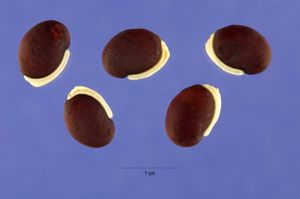Maintenance
All wikis at Biowikifarm are in read-only mode due to the restoration after a severe cyberattack in October 2023.
After 1 year being shut down the Biowikifarm is online again.
You see the latest restored version from 18th October 2023.
Lablab purpureus
Lablab purpureus (L.) Sweet
| Order | Fabales |
|---|---|
| Family | Leguminosae |
| Genus | Lablab |
2n = 22, 24
Origin : East Africa
wild and cultivated
| English | {{{english}}} |
|---|---|
| French | {{{french}}} |
Contents
[hide]Description
Popular names
- English: hyacinth bean, bonavist bean, Egyptian bean
- French: lablab, dolique d'Egypte ; antaque (Réunion) ; pois boucoussou, pois bourcoussou (Antilles)
- German: Helmbohne
- Spanish: judía de Egipto, lablab
- Portuguese: feijão cutelinho, labe labe
- Italian: fagiolo d'Egitto, lablab
- Arabic: lūbiya, lablab miṣrī
- Hindi: sem
- Chinese: biǎn dòu ; pien-tou
- Japanese: fiji-mame
Classification
Lablab purpureus (L.) Sweet (1827)
The genus name Lablab is conserved against Dolichos, with Lablab purpureus as a type.
synonyms:
- Dolichos lablab L. (1753)
- D. purpureus L. (1763)
- Lablab niger Medik. (1787)
The species is very variable, and three groups are distinguished:
Lablab Group
synonym: D. lablab subsp. lablab
Long axis of the seed perpendicular to the pod suture when mature. Seeds filling only one third to three-quarters of the pod breadth. Pod dehiscent or not.
Called papri or popetti in Hindi, such lablabs have short pods eaten for their seeds.
Ensiformis Group
synonym: D. lablab subsp. ensiformis (Thunb.) Rivals (1953)
Long axis of the seed oblique with the pod suture when mature. Pod indehiscent.
Called sem or seim, such lablabs have fleshy pods used in curries.
Bengalensis Group
synonym: D. lablab subsp. bengalensis (Jacq.) Rivals (1953)
Long axis of the seed parallel to the pod suture when mature. Pod indehiscent.
Called val or valor, such lablabs have straight long pods rectilignes, much like French beans.

Cultivars
History
Originating from East Africa, where the wild form, subsp. uncinatus Verdc. (1970), is to be found, the species has spread to India before our era, and is now cultivated in all East Asia and Oceania.


